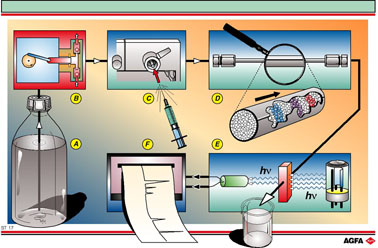ST17
Chromatographic separation of homogeneous solid - solid, solid - liquid
and liquid - liquid mixtures
| Aim:
To give a schematic representation of the working of a liquid chromatograph. |
Illustration ST 17
shows a simplified version of a liquid chromatograph. A pure liquid, or
a mixture of liquids (A) of known composition is pumped via a piston pump
(B) and an injector (C) through a column (D), passed through a detector
(E) and finally collected in a recuperation vessel.
The
mixture to be separated, in solution form, is injected into the elutant
flow using a syringe (volume : 1 - 100 µl) via the injector (C).
The elutant carries the mixture along with it to the entrance to the column.
The separation then begins. The various components separate according
to their differing relative affinities for the column packing and the
elutant. The separation process is analogous to that described in the
thin-layer method of ST 16. The particles that have the least affinity
for the column packing leave the column first. This is associated with
the concept "retention time". Those that leave the column first
have the shortest retention time. Those with the greatest affinity for
the column packing leave the column last or put otherwise elute with the
longest retention time.
The components that leave the column, the eluted components, are registered
as peaks by a detector that is connected to a recorder (F) or a PC. The
most common type of detector in liquid chromatography is based on the
absorption of radiation by the components. The amount of absorbed radiation
is directly proportional to the quantity of component present. The basic
column packing consists of porous beads of chemically modified or unmodified
silica gel (SiO2). These beads have a diameter varying between
3 and 10 µm. The column diameter varies between 2.1 and 4.6 mm and
the column length between 10 and 30 cm for standard columns. The elutants
are either mixtures of organic solvents or mixtures of water with water-
soluble organic solvents. In the latter case (in)organic salts are also
frequently added to the elutant.
